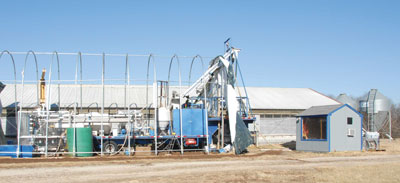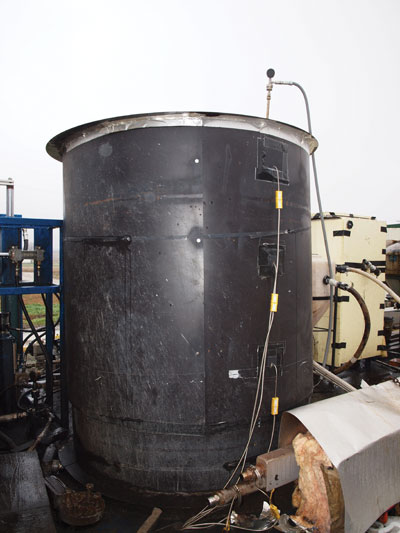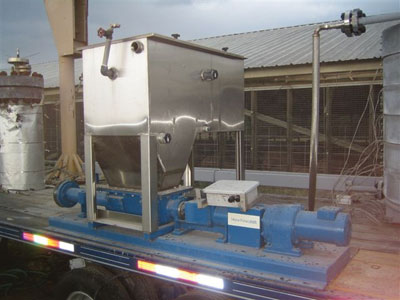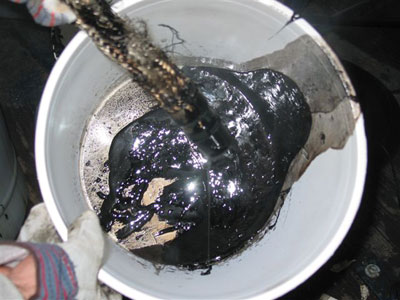
When Kent Schien, founder and CEO of Innoventor, got a call from his in-laws back in the late 1990s, he never imagined the conversation would eventually lead to pig waste being converted to enhanced bio-oil. But in the spring of 2010, the bio-oil was not only a reality, but also the first piece of asphalt road using bio-oil was laid in St. Louis, Mo.
When Kent Schien, founder and CEO of Innoventor, got a call from his
in-laws back in the late 1990s, he never imagined the conversation
would eventually lead to pig waste being converted to enhanced bio-oil.
But in the spring of 2010, the bio-oil was not only a reality, but also
the first piece of asphalt road using bio-oil was laid in St. Louis,
Mo.

|
| Innoventor took the SME (Swine Manure to Bio-Oil) technology from lab to commercialization, designing its own version, which is small enough to fit on a semi trailer. Submitted photo
|
Schien’s in-laws, Illinois pig farmers, were getting complaints from
neighbors about odors. Schien had his engineers go to work on a
solution and the engineers came up with an air scrubber. It attached to
fans in the multiple buildings and scrubbed the confinement air of
animal dander and feed dust — a major source of odors.
 |
|
| The slurry from the pig barns is fed into a reactor where the waste is heated and pressurized to become bio-oil. Submitted photo |
|
 |
|
| As the bio-oil leaves the reactor, the water (also known as black water) is separated from the oil. Submitted photo |
|
 |
|
| The final product has the consistency of molasses. Submitted photo Advertisement
|
The air scrubber was a major success when it came to eliminating odors,
but was a difficult sell to a farmer who saw it as just one more cost.
What they needed was something that not only eliminated odors but would
also generate revenue.
“We went on a search for a revenue-generating technology for our hog
farms and in 2004 ran across a University of Illinois researcher that
was turning hog manure into bio-oil,” says Rick Lux, applied technical
manager for Innoventor. “We liked the technology, and licensed it.”
Innoventor’s next step was to take the SME (Swine Manure to Bio-Oil) technology from lab to commercialization.
It took a few tries to get it right. “With our first generation, the
hog hair chewed up our pumps, so we had to develop a pump that could
handle not only the hog hair, but also handle the high pressure and the
high temperatures,” explains Lux. “We tried quite a few commercial
pumps and some could handle one or two of our needs, but not all three.
So, we designed our own.”
That scaled-up version, which is small enough to fit on a semi trailer,
went into operation on a hog farm outside the St. Louis area.
| The technology is relatively straightforward: | |
| • | The hog waste is pumped from the pits under the barns. |
| • | Next, the slurry is fed to the system where a boost pump elevates the pressure of the water slurry and heats it up. |
| • | The slurry is then fed into a reactor where the waste is heated and pressurized to become bio-oil. |
| • | As the bio-oil leaves the reactor, the water (also known as black water) is separated. |
| • | Lastly, an oil dryer finishes drying the bio-oil. |
The final product has the consistency of molasses, Lux says. “When hot,
it’s sticky and stringy like asphalt binder. And the black water stream
resembles dark tea.”
One of the things that makes the system unique is that the entire
process takes place in an hour. “And on a 10,000-hog farm, you would
get 10 to 15 barrels a day,” says Lux.
Finding a niche
The bio-oil, which initially was looked at as a potential energy
source, turned out to be a great binder for asphalt. To put it to the
test, Pace Construction Co., a St. Louis County road contractor, joined
forces with Innoventor through a Missouri Department of Agriculture
grant. Pace added the bio-oil as a part of the binder and, in April,
laid the first pig-derived asphalt to a 200-foot piece of roadway
outside Six Flags, St. Louis, Mo.
If anyone were to compare the waste-derived binder, they might smell a difference. “It smells like burnt coffee,” says Lux.
For the next year, the Missouri Department of Transportation will
monitor the heavily used piece of roadway — watching it through a full
season of freezes and thaws. In the meantime, Innoventor will be doing
its own monitoring.
“What we have proved so far is that the bio-oil is compatible with
refinery-based asphalt binder — the only place you can currently get
binder,” says Lux. “We also found that it fits into the present
infrastructure of the paving and roofing industry at an asphalt plant.
| Innoventor sees many benefits to the pig waste bio-oil besides just asphalt binder: | |
| • | Lagoons would no longer be needed and the risks associated with them would be eliminated |
| • | Land formerly used for lagoons could be converted for other uses |
| • | Odor would also be greatly reduced |
| • | What some see as an environmental negative — spreading or storing animal waste — could be used to create a value-added product |
| • | The possibility of energy tax credits |
| • | Transportation of waste would no longer be shouldered by the pork producer |
| • | It would provide a revenue stream for farmers |
| • |
The black water, a nutrient source, could be processed for flush water on the farm and the remaining concentrate could be used as a fertilizer. |
By using the manure for bio-oil, there wouldn’t be any remaining to
spread on fields. However, Innoventor doesn’t see this as a drawback
for two reasons. First, the revenue that the farmer would receive from
the bio-oil would surpass any costs for commercial fertilizer.
Secondly, the black water remaining from the process contains nutrients
and could be used to also offset the cost of commercial fertilizer.
“I would think a portion of the nutrients needed are going to be in that black water,” says Lux.
Going commercial
The reactor is currently processing one building on a 5,000 hog farm.
Although it’s not a full-size unit capable of handling the entire farm,
the company plans to build a commercial, full-sized version, which
would also include air scrubbers to handle the odor.
Innoventor is currently looking for funding to make the system
commercially available. Once that happens — they estimate within the
year — the company envisions another year before it’s ready for the
market.
The Innoventor business model has the bio-oil binder priced
significantly less than the refinery-based. “So, there would be a cost
advantage for pavers to use this asphalt binder,” says Lux.
In addition, the system would cost farmers nothing. “We envision an
agreement with the farmer to let us put the system out on the farm and
use his manure. In exchange he’ll get a percentage of the revenue from
that bio-oil,” says Lux. “Farmers would just walk by and see it run and
get a piece of the revenue. We’d service it and have tanker trucks come
pick it up.”
Lux adds, “We’re a couple of years away from that. We want to build one
or two units this year, and then next year commercialize the technology
by incorporating everything we have learned.”
In five to 10 years, they would foresee 600 to 1,000 units throughout
the Midwest. “We’d like to see 10 to 20 percent of the amount of
asphalt binder that is out there now — 31 million tons a year is used
in the paving and roofing industry. That would equate to three to six
million tons of bio-oil a year.”
Lux adds, “We also have visions of treating other manures. Swine is
where it’s started, but we want to branch out into other manures as
well. That’s one of the reasons the unit we have out there now is on
wheels, so we can take it to other types of farms.”
Not just binder
Although the paving and roofing industry is a large industry to tap,
Innoventor is also working with companies producing fertilizer
coatings. “The volume isn’t huge, but the margins are very good,” says
Lux.
Currently, coatings utilize polymers to cut down on fertilizer dust and
clumping— better known as anti-dust and anti-caking agents. By using
the bio-oil as a fertilizer coating, companies are discovering that
they not only cut down the dust, but the bio-oil also has nutrients in
it.
“Most of the coatings they use now are just benign coatings. Ours
actually coats and includes nutrients, so you could use less
fertilizer,” says Lux.
What started as a telephone call 10 years ago has now turned into a win/win situation for both Innoventor and farmers.
“The bio-oil helps clean up nuisance odors. There’s also no leaching of
nutrients into the water system from lagoons and the farmer can make
some income.”